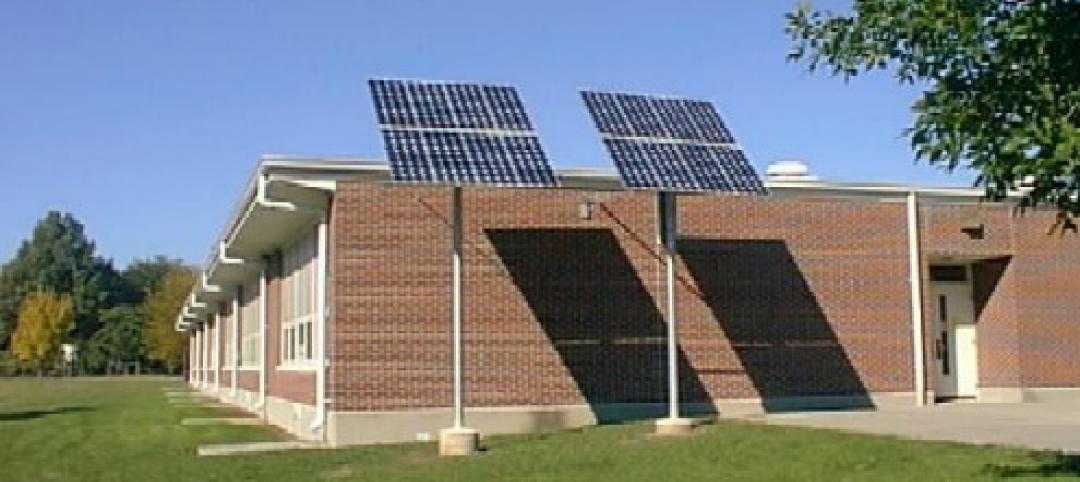Worcester, Mass., is the birthplace of vocational education, beginning with the pioneering efforts of Milton P. Higgins, who opened the Worcester Trade School in 1908. The school's original facility served this central Massachusetts community for nearly 100 years until its state-of-the-art replacement opened in 2006 as the 1,500-student Worcester Technical High School.
Getting the new 400,000-sf school opened, however, once again required pioneering efforts that earned this project and its Building Team a Special Recognition Award for overcoming significant challenges, including an environmentally sensitive site, tight funding, and labor union issues.
The school's 21-acre site in the city's Green Hill Park included wetlands with vernal pools, a 16-acre landfill, and a two-year legal dispute with neighbors over environmental and parkland issues. A formal partnering charter ultimately allayed neighborhood and environmental concerns. The school was repositioned on the site, and improvements were made to the wetlands and vernal pools, which now serve as leaning labs for the school's Environmental Technology program. The landfill was capped and converted for use as the school's athletic fields.
Funding was one of the project's biggest obstacles. To offset the school's approximately $90 million total cost (construction costs: $68 million; equipment: $22 million), the school's advisory board created “entrustment” programs, which involved partnerships with businesses, manufacturers, and major suppliers—notably Dell Computers, Cisco Systems, Toyota, and Redken 5th Avenue—to provide equipment and industry expertise in return for the school's exclusive use of their products.
Labor union issues were resolved through a deal brokered by the city's mayor and Consigli Construction (general contractor in a joint venture with O'Connor Constructors) that allowed non-union trades to bid the project. Originally, only union trades were allowed to bid, but that prevented the school's alumni who weren't union members or employees of union signatory firms from submitting bids. Trades winning their bids served as mentors to the school's current students, who gained valuable hands-on experience by helping complete their new school two months early and on budget.
|
Related Stories
| Sep 24, 2013
8 grand green roofs (and walls)
A dramatic interior green wall at Drexel University and a massive, 4.4-acre vegetated roof at the Kauffman Performing Arts Center in Kansas City are among the projects honored in the 2013 Green Roof and Wall Awards of Excellence.
| Sep 19, 2013
What we can learn from the world’s greenest buildings
Renowned green building author, Jerry Yudelson, offers five valuable lessons for designers, contractors, and building owners, based on a study of 55 high-performance projects from around the world.
| Sep 19, 2013
6 emerging energy-management glazing technologies
Phase-change materials, electrochromic glass, and building-integrated PVs are among the breakthrough glazing technologies that are taking energy performance to a new level.
| Sep 19, 2013
Roof renovation tips: Making the choice between overlayment and tear-off
When embarking upon a roofing renovation project, one of the first decisions for the Building Team is whether to tear off and replace the existing roof or to overlay the new roof right on top of the old one. Roofing experts offer guidance on making this assessment.
| Sep 16, 2013
Study analyzes effectiveness of reflective ceilings
Engineers at Brinjac quantify the illuminance and energy consumption levels achieved by increasing the ceiling’s light reflectance.
| Sep 11, 2013
BUILDINGChicago eShow Daily – Day 3 coverage
Day 3 coverage of the BUILDINGChicago/Greening the Heartland conference and expo, taking place this week at the Holiday Inn Chicago Mart Plaza.
| Sep 10, 2013
BUILDINGChicago eShow Daily – Day 2 coverage
The BD+C editorial team brings you this real-time coverage of day 2 of the BUILDINGChicago/Greening the Heartland conference and expo taking place this week at the Holiday Inn Chicago Mart Plaza.
| Sep 4, 2013
K-12 school design that pays off for students
More and more educators are being influenced by the Reggio Emilia approach to pedagogy, with its mantra of “environment as the third teacher”—an approach that gives Building Teams a responsibility to pay even closer attention to the special needs of today’s schools.
| Sep 3, 2013
'School in a box' project will place school in San Diego public library
Thinking outside the box, LPA Inc. is designing a school inside a box. With an emphasis on three E’s—Engage, Educate, and Empower—e3 Civic High is now being constructed on the sixth and seventh floors of a public library in downtown San Diego. Library patrons will be able to see into the school via glass elevators, but will not have physical access to the school.
| Aug 30, 2013
Modular classrooms gaining strength with school boards
With budget, space needs, and speed-to-market pressures bearing down on school districts, modular classroom assemblies are often a go-to solution.
















